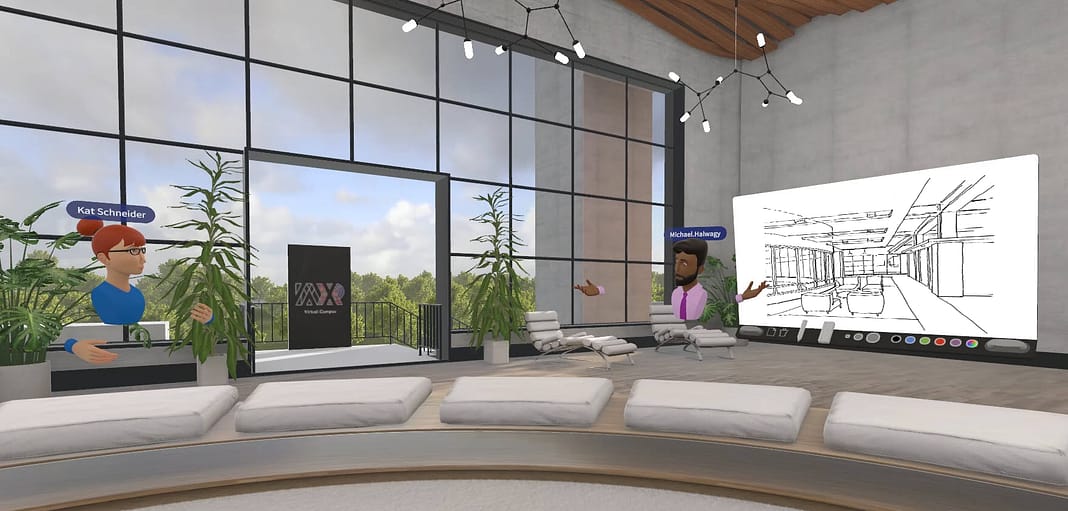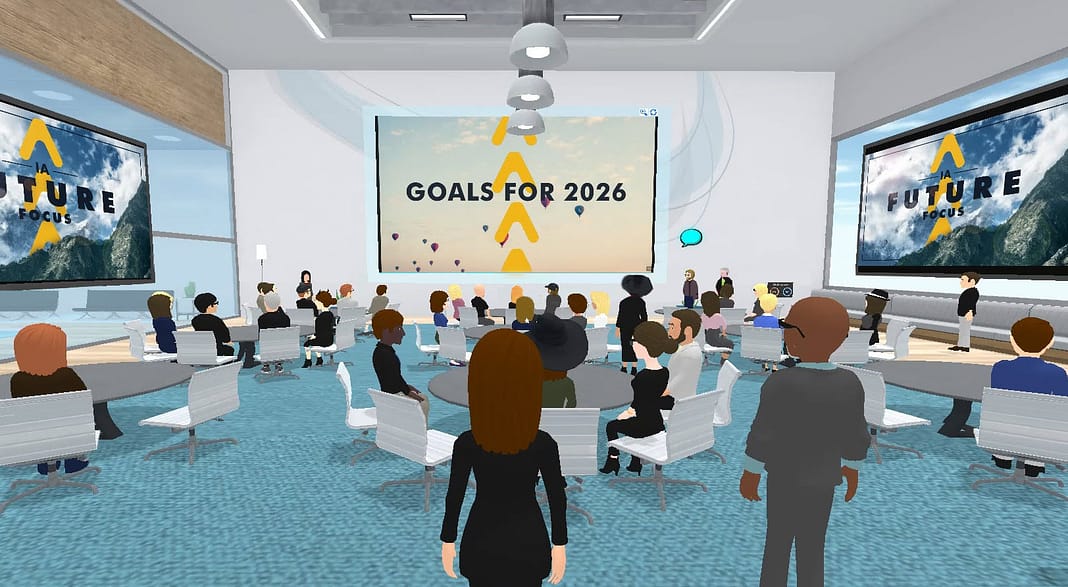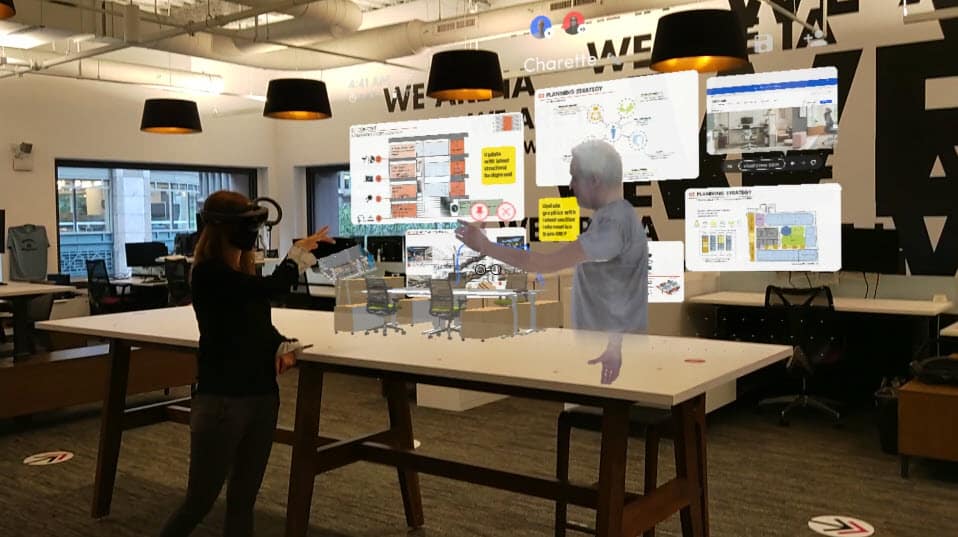By David Bourke | IA Co-CEO and President
&
Kat Schneider | IA Digital Design Application Specialist
As architects and designers we traditionally think of space as three dimensional, bound by dimensions of height, depth, and width. But augmented reality and virtual reality are changing that paradigm, adding a fourth dimension that is altering the way we perceive and interact with the world. We are all familiar with the technologies sci-fi movies have predicted: the communicator in Star Trek became the template for the modern smartphone; the 3D holograms in Star Wars are now operational; the tablet from 2001: A Space Odyssey became the template for the iPad; and the holodeck in Star Trek is today’s immersive virtual reality. These technologies continue to integrate their way into our day-to-day life. The adoption of augmented reality, virtual reality, and mixed reality can now expand our senses and present new dimensions, experiences, and information that are not bound by our traditional notions of space.
With these new possibilities in mind and tasked with enriching the physical and emotional needs of those who occupy space, how do designers and architects respond to a world where people and teams are dispersed, working from home, and living a Zoom-centric lifestyle? We respond by adapting transformative technologies such as extended reality (XR) to enhance the user experience. XR is a hypernym for experiences that combine real context with virtual elements in a seemingly realistic way and include virtual reality (VR), augmented reality (AR), and mixed reality (MR). The application of each can vary from providing an interactive desktop platform to a completely immersive digital environment to a mixed reality experience that enhances the user’s real world context with information and digital content.
These technologies have been our inspiration for establishing IAXR, a transformative practice that merges interior design, architecture, art, and technology to create integrated solutions and innovative ways of working that move the focus well beyond the limits of space. This dedicated group works alongside our designers, architects, and clients to promote and inspire new thinking about the design of space and the application of virtual environments is all its forms.
We are constantly learning about and evolving the concept of space to be broader and more inclusive. As a development partner with several companies at the forefront of this technology evolution, IAXR is currently in the R&D phase of multiple projects with several organizations ranging from financial services firms to consumer products to technology companies. Our initial findings suggest that by continuing to augment virtual environments through XR, a wealth of benefits will result, including more sustainable, wellness-focused, and equitable workplaces that strengthen the brand and culture of organizations while bringing dispersed groups together in more satisfying ways.
The pandemic has accelerated the stakes for the development of XR space exponentially further and faster. As the technology becomes more accessible both in form factor and cost, extended reality experiences will lessen the connection gap that remote work has created. IAXR is focused on adapting technologies to support each client’s bespoke scenario for engagement. Examples include crafting custom environments that respond to the needs of an organization where remote work, mentorship, and learning feel more like connecting with coworkers in the office or a conference room and less like occupying a box on a Zoom call grid.
In a typical XR meeting, you will find geographically dispersed participants wearing immersive headsets like the Oculus Quest 2 or the Microsoft HoloLens 2. These wearable devices represent the technology’s future-facing trajectory. The shift is already underway transitioning from a current relationship with a screen that you carry with you or spectate from to a highly personalized device centered around what you wear and the experiences you inhabit. As the separation between us and our tech continues to diminish, many more opportunities to acknowledge and accommodate individual needs and abilities, particularly within the context of work, are established. Environmental aspects such as light, sound, and color move away from standardization to settings that can be altered and are uniquely responsive to each user’s comfort.
Once inside a virtual environment, the rules shift from what we have come to know about physical space. Things like movement by teleportation, being able to scale objects with your hands, or even use voice commands to easily call up different images and 3D models are some examples of new types of interaction. The physical presence of others through avatar representations of self enhances the immersion and sense of connection to colleagues.

The physical presence of self and others as avatar representations along with a shift in the rules about physical space enhance immersion in a virtual environment. Image © IA Interior Architects.
Meeting with others to collaborate is just the beginning—XR is well suited to facilitate deeper interpersonal understanding of events like social gatherings, networking, team-building retreats, interviews, and mentorship opportunities. Customizations of environments and interactions also establish new methods for occasions like job orientations, skill-based training, or even the spontaneous connection with teammates at amenity hubs. This medium allows for the freedom to combine the excitement of a new cutting edge technology with the comfort of a familiar environment, office space, or campus that you already know and love.

Customizations of environments and interactions establish new methods for a variety of occasions including all-hands meetings. Image © IA Interior Architects.
The concept is relatively simple. When IA designs a space we also create a virtual recreation of that space where people can meet, collaborate, and operate. You, represented as an avatar, will be able to interact with the avatars of others who are in the space—clients, friends, and coworkers. As you speak to colleagues, an enhanced realism is brought to life through their gestures, as well as movement around the space, the presentation of work, brainstorming on whiteboards, watching videos together, and, yes, even giving high-fives. This experience allows users to break free of the two dimensional boundaries of the all-too-familiar Zoom call and inhabit an environment that leaves room for experimentation in a structured work setting less gamified than a video game.
“I have long struggled to find the best way to brainstorm and develop new ideas with my team when we all are working remotely. Interactivity is key, and being in the same room with your co-workers makes all the difference. Traditional methods of remote collaboration ease some of the pain, but extended reality steps up the experience several levels. The combination of VR technology and the modeling of realistic spaces creates a setting that boosts creativity and productivity by feeling almost actual, allowing genuine interaction—extending physics in a thoughtful way can be very helpful. All of a sudden, you are in the same room with your colleagues again. It was surprising and comforting to see spaces that IA has designed for us in the physical world appear in virtual reality, to experience how the wisdom of architecture and cutting edge technology can combine to help teams work better.” — Jan Amtrup, Sr. Director, Data Science, Capital One
With this new technology onboarding is a critical step in the process. The way in which any first-time user is acquainted with XR is important. To begin the process, our team initially spends an appropriate length of time in the virtual workspace doing training sessions, interacting with content and tools, and talking with other avatars. As we continue to use and develop this technology within our company, we work directly with our clients and our dispersed teams in XR. This allows us to enter virtual-space project meetings, pull a 3D model of a new office layout into the space, and consider it from all angles for any needed design modifications.

We work directly with our clients and our dispersed teams in XR. Image © IA Interior Architects.
Virtual reality, which has been more largely adopted to date, presents multiple interesting opportunities for the workplace, although VR headsets are not for everyone. Mixed reality and forms of augmented reality are well positioned to accommodate the need to combine physical context with virtual presence. Using a mixed reality device, like the HoloLens 2, users can host meetings with participants as avatars that look like they are actually sitting in a chair at their office. With the integration and adoption of spatial audio systems, it even sounds like they are sitting right next to you. Although in its infancy, this technology is rapidly evolving and developing with advancements in lightweight hardware such as smart glasses and 5G connectivity, which will continue to improve the user experience making it even more immersive and realistic.
While all of this is incredibly exciting, like any new technology the growth of VR, AR, and MR also presents new challenges. The current state of play generally requires participants to interact through headsets, which can be limiting in terms of duration of use and connectivity. Also, extended reality environments are processed by the brain neurologically as if they are real, physically lived experiences, which places an immense importance on each and every designed aspect of a space; there is more at stake if the experience triggers an adverse reaction or creates an unforeseen barrier.
This new technology can also increase the burden on resources and, as a result, create more exclusion. The digital divide during the pandemic has led to vastly different experiences as many with internet access and up-to-date equipment enjoy the benefits of remote work and learning, while those without access or a remote option struggle to keep up. There are also concerns around what the technology itself can do. If you assume that smart glasses will be equipped with cameras and other sensors, it is likely they will introduce a myriad of privacy concerns. We continue to embrace and create space for these complexities in our conversations around XR, and look for ways to advance accessibility and reduce the barriers to entry in this ecosystem. The possibilities that XR represents are enormous, and fortunately the pace of change and amelioration of associated pain points and concerns is rapid.
With XR technology we enter a new realm of possibilities that creates a very purpose-driven experience to connect and educate customers, employees, and clients, while demonstrating a commitment to innovating new ways of working and building cultures through digital transformation. Immersive technologies provide an opportunity to augment physical space that can play a significant part in the process of training, design, and marketing.
By adopting XR technology an organization will be more powerfully connected, its culture more effectively supported, its foundation stronger, more able to connect with clients. At a time when the user experience is paramount, embracing this technology and its possibilities will give an edge to user organizations for the future. As the physical and the virtual are blurred, we are excited, enthusiastic agents in the development and application of XR technology to the work environment. We are prepared to answer all questions as well as demonstrate the prowess of IAXR as we continue to design space in all its forms.


